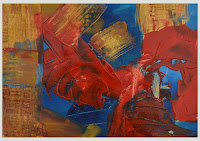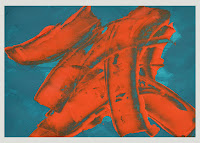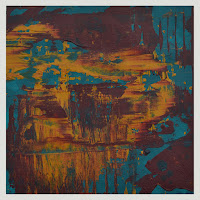‘Painting Realistic Abstracts’ mostly had examples of watercolour paintings and I wanted to work with acrylics. This book will come in handy in the future. The artist Kees Van Aalst is truly gifted and provides lots of examples of what makes a painting good; but doesn’t explain the how to. This book will be useful after I have more painting experience and know more about watercolour techniques.
‘Painting Abstracts, Ideas, Projects & Techniques’ by Rolina Vliet is an excellent book, it has tons of information about everything. Each chapter has a different subject with explanations and exercises to go with it. For every project there is an explanation on theme/emphasis, picture element, composition, materials, technique, work sequence, tips and variation exercises. The examples they provide are interesting and beautiful, unfortunately my experiments didn’t come out as nice. Taking notes on what worked and what didn’t for future projects is the right way to go. The exercises in the book are broken down into five sections; Primary Picture Elements, Secondary Picture Elements, Composition, Technique and Material, Theme and Project.
Primary Picture Elements- Exercises 1-5
 1 Expressive Shapes – design a surface divided by spontaneous lines, apply colours roughly with a pallet knife. My first try there were too many colours, it looked like a child drew it. The second was using only neutral colours and I liked it better. The third used only three colours, and turned out the best.
1 Expressive Shapes – design a surface divided by spontaneous lines, apply colours roughly with a pallet knife. My first try there were too many colours, it looked like a child drew it. The second was using only neutral colours and I liked it better. The third used only three colours, and turned out the best.3 Geometric shapes – didn’t like the way the two paintings came out. The first had a black background and the colours on top were not saturated enough so the back showed through. The second was using tape to get clean lines, but the tape didn’t pull up correctly. Probably should have included an example but it's too embarrassing.
4 Free shapes using oil pastel crayon – did three only one came out half way decent. Again too embarrassed to include pictures.
 5 Spontaneous shapes – painting in layers, start with an underpainting and let it dry. Using only two or more colours these paintings were pretty successful.
5 Spontaneous shapes – painting in layers, start with an underpainting and let it dry. Using only two or more colours these paintings were pretty successful. 
The first was with cadmium orange and modelling paste over turquoise, a third colour wasn’t necessary.
The second was with turquoise, yellow ochre and burgundy, square instead of landscape.
Did a few others and liked them as well; the spontaneous shapes study is my favourite so far.
Colour - Exercises 6-11
6 Mixing with colour blending – used cobalt blue, primary yellow and paynes grey, painting was very dark looking and it was difficult to blend colours. I didn’t like this exercise.
7 Mixing with a palette knife – the first painting came out muddy, the second I used a scrapper to pull colour off and it looked nicer but not great. Sorry once again...no photos.
You would think I would have a handle on colour after reading the book on it, but for some reason the colour chapter was not working for me. I got discouraged and stopped doing the exercises.
There are a great many things to learn in this abstract book and when I get my confidence back I will carry on. That should be a t-shirt 'Lost confidence just CARRY ON anyway'. It really is fantastic and one of the best I have bought so far. I would highly recommend Painting Abstracts, Ideas, Projects & Techniques’ by Rolina van Vliet. Look for more exercises from this book in future blogs.

No comments:
Post a Comment